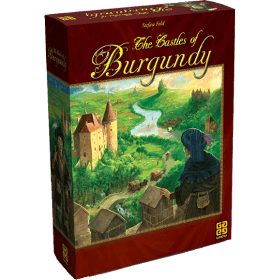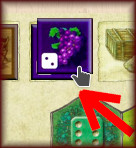The Castles of Burgundy
 Use your dice to build settlements and powerful castles, practice trade along the river, exploit silver mines, and use the knowledge of travelers.
Use your dice to build settlements and powerful castles, practice trade along the river, exploit silver mines, and use the knowledge of travelers.
You'll score points when breeding animals, completing regions, selling goods, and various other means.
But you'll have to play wisely in order to to be able to use your dice whatever number is rolled, otherwise you'll have to use workers... if you still have some!
Number of players: 2 - 4
Game duration: 35 mn
Complexity: 3 / 5
Play The Castles of Burgundy and 974 other games online.
No download necessary - play directly from your web browser.
With your friends and thousands of players from the whole world.
Free.

Play The Castles of Burgundy and 974 other games online.
No download necessary - play directly from your web browser.
With your friends and thousands of players from the whole world.
Free.

Rules summary
⚠️ There is an error in the English translation (and in some other languages) of the rule book of the physical game. The tiebreaker rule should be:
- “If there is a tie, the player with the most unused hex spaces in their duchy wins the game”
⚠️ There are a few differences in the rules between 1st and 2019 editions (see below in Game options).
Rules of the game
See the rules PDF on the Ravensburger site.
Interface help
Game actions
- If you want to buy a tile, you just have to click on it (see special case below).
- If you want to use a die to perform an action, you must first select the die, then:
- to take a tile from the main board to your storage, just click on it
- to place a tile, first click on the tile you want to place, then click on one of the possible spaces (they're highlighted, unless you have chosen the Display almost nothing choice for the Possible moves display user preference)
- to sell goods, just click on one of them
- to take workers, click on the worker icon on your player board, below your goods storage.
- Workers are automatically used if needed. They appear afterwards in the log message, but if you want to be sure before your action of how many workers are needed, you can enable the Display workers needed user preference.
- Green borders mean "available / possible", blue borders mean "selected".
Special case
In general, to avoid useless clicks, you only need to click on a tile to buy it, without having to specify you want to buy it. This is possible because in general, no confusion is possible since the tiles you can buy are not the same that the ones you can take with a die. And even with yellow tile #6, you need to select a die first if you want to take a tile (not buy it).
But sometimes (yellow tile #6 in 2019 edition), one click is not enough. In these cases, you should still first click on the tile you want to buy, then you will be asked if you want to buy it with workers or silverlings, and if you're in the middle of an action with a castle advantage, you will be asked if you want to buy this tile or if you want to take it with the castle advantage.
Hints
- You can undo your whole turn at any time during your turn by clicking on the Undo red button in the action bar. Other players don't see your actions in their interface until you have confirmed your turn, and they see only your confirmed actions, so it won't bother them and mess their game log. But some information is not totally hidden: some users could know about the type of tiles you placed (a castle, a ship or some of the buildings). So if you really want to hide your plans for future turns, just think before you click and don't place tiles unless you're sure you will actually confirm that you place them. Note that players replaying a finished game from your point of view will see all your trials and undone actions.
- It is not and it will not be possible to cancel only your last move, you can only cancel your whole turn (too much programming work, not worth it, and if you're afraid of not remembering the moves you played when you undo your whole turn, they're still visible in the game log).
- A die can be unselected (you can also directly select the other die) if you change your mind and want to use the other die, or buy a tile before. If you have selected a tile in your storage to place it in your estate / duchy, you can also unselect it, or directly select another tile.
Display
- You can click on the button next to a player's name (under the order track discs on the main game board) to move this player's board to the beginning of player boards (this can avoid having to scroll too much when you want to see your opponents' boards).
- Don't forget that like in any BGA game, you can disable tooltips (in the user preferences menus) if they annoy you. You still have the Tile help section below the player boards if you need help.
- You can display sold goods: there are tooltips on the stack of your sold goods. If you have a mouse, you can hold your pointer above your stack, if you're using a touch device, you can usually display tooltips with a long press (or a "double then long" press).
- If you can't display tooltips with your touch device or if you selected the "no tooltips" user preference, you can still display sold goods by clicking on the sold goods stack.
- With the Zoom level User preference, you can resize all the game elements to fit your screen width: make them smaller to be able to see more boards at the same time, or make them bigger to enjoy bigger images. User preferences are accessible with the cog icon in your player panel, or, like in any BGA game, with the "hamburger menu" a the top right of the page, or in the Options tab at the bottom of the page.
- In 3 players games, one of the space for six-sided tiles next to depot 6 (on the main board) is half dark green, half grey, with letters on it. This is to remind players that in 3 players games, this space gets a castle tile in phases A, C and E, and a mine tile in phases B and D.
Replay
It is not possible to start a replay from one of the moves that happened during one of your turns. You can start a replay from any other point.
Game options
Differences between 1st edition and 2019 edition
- Two yellow six-sided tiles (called knowledge tiles in 1st edition and monasteries in 2019 edition) award a different number of points (see image)
- Another yellow tile (#6) is different: in addition to let you buy tiles in numbered depots, it lets you buy tiles (anywhere) with two silverlings OR TWO WORKERS.
- In 2019 edition, you are allowed to buy a tile during your action.
Note: the implementation on BGA doesn't allow to buy a tile at any moment, because it would not be useful. You can do it only when you just placed a castle or a city hall.
- New art for six-sided tiles, goods tiles and bonus tiles (the new art for other game elements is not included in this online implementation because it wouldn't fit).
- One more player board, labelled number 2 in 2019 edition, and available in 4 copies so that it can be used for beginner setup. This board is available in both 1st edition and 2019 edition options of this implementation. The board that was labelled number 2 in first edition was given number 10 in 2019 edition, so it has number 10 in this online implementation, regardless of the chosen edition option.
- A few confusing name changes. I tried to avoid possible confusions in this implementation: some of the in-game text is different depending on which edition you play (e.g. estate / duchy), while for other elements, I decided to use the same term in both editions (e.g. yellow tile for knowledge tile / monastery).
Different game setup options
The default option on BGA is Random board without board #8, and not Beginner setup, because it is probably the most interesting for most players, and it is not really problematic if beginners join games with this option. But they can be disadvantaged if they choose a poor space for their starting castle, so beginner setups are still better choices for beginners (they don't have to choose a starting castle space), even if other options are not strongly discouraged.
- Classical setup: this is the setup described at the very end of the rulebook: each player is given a two-sided estate / duchy cardboard, and must choose one side. To simulate play with the physical game, two players can't have the same cardboard.
- One random board per player: each player is given a single random duchy / estate among available ones. Two players can have the same duchy / estate.
- Random board without board 8: same as above, but board #8 is removed from available boards (many consider this board unbalanced).
- Identical (random) board for all players: all players play with the same board, randomly chosen among available boards.
- Beginner setup: all players play with the same beginner board, with their first castle already placed in the middle. This option exists in three variants: with board #1, with board #2, or with a random board among #1 and #2 (the same board for all players).
User preferences
Workers needed
The number of workers needed for each action you can do with a die can be displayed next to the tiles you can click.
Possible moves display
Possible actions can be highlighted with a green border. This is an option because some players will find these big green borders not good-looking, especially when there are a lot of them at the same time. There are three options for this preference:
Always display all possible moves
Every place you can click to trigger an action, that is not a blue or red button, is highlighted with a green border.
Display non obvious possible moves
Non obvious is subjective, the choice made was to display only tiles that can be placed and possible estate / duchy destinations for the Place tile action, and tiles that can be taken for free from the main board, with a church, market or carpenter.
Display almost nothing
The only things that will be highlighted are the Take workers icon, and the depots when you have to choose goods after having placed a ship, because since these are not tiles, it's not obvious where to click to trigger these actions.
Estate / duchy background
You can choose to display a lighter background for estate spaces, which will make the tiles stand out more.









